David Suzuki's Blog, page 64
June 18, 2015
Irrational attacks have long history of diminishing debate
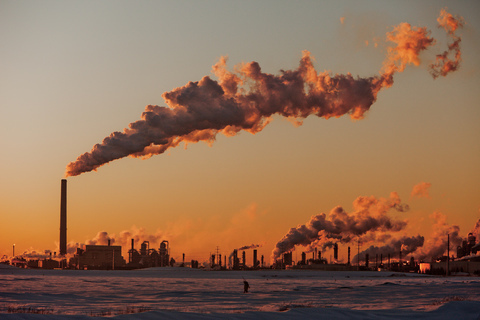
(Credit: Kris Krug via Flickr)
In 1962, biologist and writer Rachel Carson published Silent Spring, a book about the widespread use of agricultural pesticides, and how toxic chemicals like DDT were threatening insects, birds and other elements of our natural world. It garnered widespread critical and popular acclaim and is heralded as the catalyst for the modern environmental movement.
Carson's ability to describe in simple but passionate language the great damage caused by pesticides, and her courage to express controversial ideas that rankled powerful business and political interests, helped propel the book to massive success.
Agrochemical companies responded with furor, threatening the publisher with a libel lawsuit and launching well-funded public relations campaigns touting the safety and necessity of agricultural chemicals. Critics of Silent Spring also attacked Carson personally, accusing her of being radical, unpatriotic and sympathetic to communism -- a serious threat during the height of the Cold War.
Even though Carson was a well-educated biologist with a master's degree in zoology, she was dismissed as an amateur and a "hysterical woman" in industry journals and the popular press.
Fortunately, she remained steadfast despite the attacks, and we have all benefited. Dangerous pesticides like DDT have been restricted and laws to protect the health of the environment and communities have been enacted around the world. But sadly, harassment and intimidation of environmental advocates continues. Some would argue it has worsened with the rise of social media, which amplifies messages of hatred and intolerance, often under the cowardly cloak of anonymity.
We witnessed a recent example when David Suzuki Foundation senior scientist Faisal Moola was attacked on social media for supporting a campaign -- on his own time as a private citizen -- asking Tim Hortons to stop running ads for controversial oil sands pipeline company Enbridge on its in-store TV channel. The company had been running the commercials in about 1,500 Tim Hortons coffee shops in an attempt to resurrect its sinking brand among Canadians.
Moola was one of 28,000 Canadians who wrote or tweeted to ask Tim Hortons to pull the Enbridge campaign from its network, but he was singled out for attack by right-wing oil sands promoter and pundit Ezra Levant, who accused him on Twitter of being a "foreign-funded extremist" responsible for Tim Hortons' decision to stop running the ads.
At one point Moola's name was trending nationally on Twitter, largely because of the barrage of hate messages he was receiving every few minutes, including many xenophobic and racist attacks on his ethnic background and Muslim religion. He was accused of being "anti-Canadian", an "extremist" and even a "terrorist" because of his opposition to oil sands expansion -- even though 100 fellow scientists just released a public statement calling for a moratorium on oil sands development.
Moola's experience, like that of Rachel Carson's a half-century earlier, shows that environmental advocacy has never been easy. As Heiltsuk community organizer and First Nations leader Jess Housty says, "Activism is hard. It pits you against forces that have a lot at stake, and who fight dirty and bite back hard."
I've spoken to thousands of environmental and community activists during many years of meeting with Canadians across this country. I've heard too many stories of people being harassed, ostracized, sued for standing up to large corporations and even fired from jobs because of their environmental advocacy.
Canada is blessed to have strong laws that protect human rights and prohibit hate speech, and the courts have held accountable those who've defamed people with xenophobic accusations. And we rarely have to fear the levels of violence faced by environmental and social justice advocates in other parts of the world. But recent polls reveal the uncomfortable truth that many Canadians hold intolerant, even racist, beliefs.
Reading comments sections of online publications and Facebook and Twitter posts and listening to call-in radio shows can be disheartening. People often express the worst of their tribal instincts on these public forums, and discussion of difficult issues like the oil sands often degenerates into personal, irrational and sometimes hateful rhetoric.
Canadians must continue to speak out for our water, land, air and wildlife, for justice for Indigenous Peoples, and for a clean energy future -- without fear of harassment, intimidation and hatred.
Hey! Want more DSF? Join David Suzuki on Facebook

Righting the wrong in the Rouge
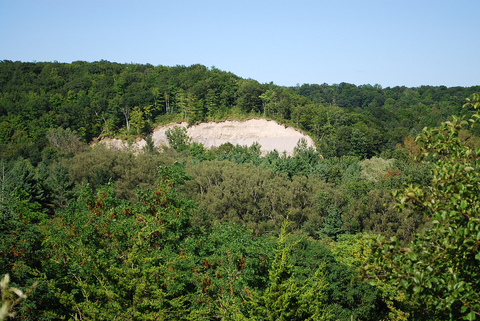
Earlier this year, parliament passed a law establishing Rouge National Urban Park, Canada's first urban national park, in the GTA. Sadly, this was . The legislation fell well short of provincial, national and international standards for protected areas and does not even mandate nature conservation as the priority in park management.
The Rouge is a Park in name only.
A private member's bill introduced this week, would fix many of the flaws in the legislation and establish a more acceptable precedent for development of urban national parks in other parts of the country. Importantly, Bill C-696, An Act to amend the Rouge National Urban Park Act, stipulates:
The [Environment] Minister must, when considering any aspect of the management of the Park, give priority to the restoration and maintenance of ecological integrity through the protection and restoration of natural resources and natural processes, while also giving consideration to cultural heritage, farming, and public infrastructure needs.
The originally proposed Rouge National Urban Park encompasses a 6,000-hectare (60 square kilometre) green swath of wetlands, fields, farms and forests straddling the border of Toronto, Scarborough and Markham, following the Rouge River watershed from the Ontario Greenbelt to Lake Ontario. The area has a rich cultural, agricultural and ecological history and is home to two National Historic Sites and more than 1,000 plant, animal and bird species.
However, out of concern for the sub-standard environmental protections in the Rouge legislation, Ontario has so far declined to transfer provincial lands to the federal government for the park. As a result, Rouge National Urban Park not only lacks the legal guarantees of environmental protection Canadians rightly expect in their national parks, the new park currently covers about two square kilometres.
When Scarborough MP, Rathika Sitsabaiesan (NDP), introduced Bill C-696 on June 17, 2015, she expressed her hope for, "a people's park [that] will continue to be the gem in everybody's backyard in the City of Toronto and the Greater Toronto Area."
With the House of Commons scheduled to adjourn for the summer in less than a week, Bill C-696 is unlikely to come to a vote. But when MPs return to Ottawa after the fall election, fixing the Rouge National Urban Park Act should be a priority, because the Rouge truly is an ecological treasure worth preserving for Canadians today and into the future.
Hey! Want more DSF? Join David Suzuki on Facebook

June 17, 2015
Why is Quebec waiting to ban bee-killing pesticides?
36,000 Quebecers call on the Quebec government to ban neonicotinoid pesticides now
Montreal, June 17, 2015 - Équiterre and the David Suzuki Foundation today presented the Minister of Sustainable Development, Environment and the Fight against Climate Change with letters from 36,000 Quebecers calling on him to ban the sale and use of neonicotinoid pesticides (neonics). In the wake of the Ontario government's adoption of a regulation aimed at reducing the number of acres planted with neonic-treated corn and soybean seeds by 80% by 2017, environmental groups are demanding that Quebec also restrict the use of these pesticides, which are hazardous to the environment and potentially to human health.
"The evidence is well established with regard to the negative impact of neonics on bee health. Given that 70% of our crops and 35% of our food production depend on the work of pollinating insects such as bees, this is very worrying," says Madeleine Chagnon, associate professor in the Department of Biological Sciences at the Université du Québec à Montréal and co-author of the largest review so far of scientific literature on the environmental impact of neonics, which was recently published by the Task Force on Systemic Pesticides, an international group of 50 independent researchers.
"Cases of neonic poisoning were found in my apiaries during the planting season in 2014. This situation concerns me and we need to act quickly to stop these losses," says Alexander Gardner of Miel Gardner, located in St-Norbert-d'Arthabaska.
**Voluntary approach is not enough
**
For nearly two years, the Quebec government has opted for a voluntary approach to this issue, inviting the farming community to use neonic-treated seeds in a reasoned way and asking seed merchants in Quebec to increase their offer of seeds that have not been treated with these pesticides. However, "getting seeds that haven't been treated with neonics is very difficult," says Heidi Asnong, a producer of field conventional crops (corn and soybeans) in Montérégie, who has chosen not to use neonic-treated seeds. "I had to be very persistent to do so," she says.
"It's obvious that the voluntary measures proposed by the Quebec government for the past two years are clearly insufficient: a regulatory approach is needed. Europe and Ontario have understood this: what are we in Quebec waiting for?" says Sidney Ribaux, Executive Director of Équiterre.
Bees and other non-targeted species may not be the only victims. Exposure to neonics through food and water raises public health concerns and the European Food Safety Authority considers that some neonics may also harm the development of the human nervous system.
According to a leaked Pest Management Regulatory Agency analysis, neonics seed treatments contribute little to corn and soybean production in Canada - 3.6 per cent in the case of corn and 0.4 per cent in the case of soybeans. "Considering the risks to health and our environment, the widespread use of these toxic pesticides cannot be justified, especially given their limited value in agricultural production," says Lisa Gue, senior researcher and analyst with the David Suzuki Foundation.
Used for just about a decade, neonics have become the most widely used class of insecticide in the world, claiming 40 per cent of the global market. In Quebec, almost all grain corn and between 35 to 50 per cent of soybean seeds are treated with neonics -- affecting some 550,000 hectares of crops every year.
- 30 -
For more information:
Nadine Bachand, Project Manager, collective choice, agriculture and pesticides, Équiterre
Tel. 514 213-3287 / nbachand@equiterre.org
Lisa Gue, Senior researcher and analyst, David Suzuki Foundation
Tel. 613-914-0747/ lgue@davidsuzuki.org
Hey! Want more DSF? Join David Suzuki on Facebook

June 16, 2015
Ontario will profit from being kind to bees
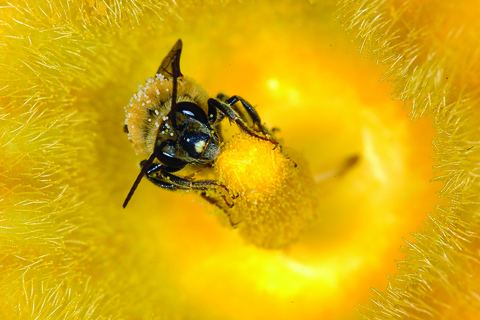
(Credit: Amro Zayed)
Last week, Ontario officially posted amendments to its pesticide regulation that will restrict the use and sale of seeds treated with neonicotinoid pesticides. It's a North American first, but other jurisdictions are sure to follow suit. Evidence-based decision-making requires a global phase-out of these chemicals.
The evidence is clear. A comprehensive analysis of more than 1,200 scientific studies on the ecological effects of neonics, conducted by the international Task Force on Systemic Pesticides, concluded that neonics harm bees, as well as other non-target species.
Beekeepers in Ontario and Quebec have witnessed the acute, lethal affects first-hand. Reports of sudden bee die-offs during planting season in corn- and soy-growing areas prompted Health Canada to investigate. They detected neonic residue in the bodies and hives of dead bees and concluded that neonic-laced dust -- generated when treated seeds are planted -- is contributing to bee mortality.
Long-term effects are more insidious, though they receive less attention. Neonics are nerve poisons. Repeated exposure even at low levels can interfere with the information-processing abilities of insect pollinators and other invertebrates. The Task Force study uncovered evidence of impaired sense of smell and memory, effects on reproduction, altered feeding behaviour and increased susceptibility to disease.
Moreover, neonic seed treatments appear to have little benefit to agricultural production. A leaked federal government analysis estimated neonics contribute just 0.4 per cent of the total value of soy production in Canada and 3.6 per cent in the case of corn. This is consistent with a similar U.S. EPA assessment.
No justification exists for continuing to contaminate our environment with harmful chemicals that serve no useful purpose. Currently, virtually all corn and 60 per cent of soy planted in Ontario is treated with neonics as a matter of course. Ontario's new regulation aims to reduce these uses by 80 per cent by 2017, allowing neonics only where relevant insect pests are present. Given the evidence of harm and their negligible value to agriculture, an outright ban on neonics would be reasonable and simpler to implement.
So why haven't the federal government and other provinces taken action on neonics? The pesticide lobby and some agricultural interests are running a well-funded campaign to oppose any restrictions, including ads in papers across the province, including the Toronto Star. Globally, neonic sales are worth $2.6 billion a year, so the potential war chest to fight any controls on neonics is considerable. But pollinators must trump profits. Our food supply depends on it.
After Italy banned the use of neonic-treated corn seed in 2008, sudden bee die-offs in corn-planting regions were virtually eliminated within one year. The Italian Beekeepers' Association reported that hives were flourishing again, while crop production did not suffer. Other countries in Europe took note and a moratorium on certain uses of neonics throughout the European Union was introduced in 2013. We can expect similar results in Ontario.
Ontario's determined effort to wean the province from neonics demonstrates that, despite fierce pushback from multibillion-dollar companies profiting from pesticide sales, strong science bolstered by public support for protecting pollinators is prevailing. This is good news story -- one that other provinces and the federal government should follow closely.
Hey! Want more DSF? Join David Suzuki on Facebook

June 15, 2015
David Suzuki honoured by Howe Sound First Nations
By Theresa Beer, Communications Specialist. Reprinted at SustainableHoweSound.ca
With stunning Howe Sound as backdrop, David Suzuki was honoured by, and adopted into, the Squamish Nation during the Blue Dot Tour stop at Porteau Cove in November, 2014.
In a traditional Squamish welcoming ceremony, David and fellow canoe paddlers were called back to the shore to begin the day's events. Chief Ian Campbell spoke of the Squamish Nation's respect for David's work on environmental stewardship and with First Nations. David, he said, shared an understanding with First Nations about nature and interconnectedness. Carleen Thomas, a Tsleil-Waututh Nation leader and member of the Sacred Trust Initiative, also honoured David and his long history protecting B.C.'s coastal waters.
The moving ceremony, which included a presentation to David of a traditional cedar cape and head band, marked the deepening relations the Foundation has with Howe Sound First Nations. Volunteer divers with Marine Life Sanctuaries Society gave families and children opportunities for close-up interactions with starfish and other marine treasures from Porteau Cove, a popular scuba diving destination.
As work to create a long-term vision and plan for the Howe Sound region gains momentum, the Squamish Nation's commitment to take a marine planning leadership role is creating a way forward for conservation.
Communities in the Howe Sound region are joining local governments to protect the people and places they love. Squamish, Bowen Island and the Islands Trust B.C. are among the more than 50 local governments representing more than five million Canadians that have passed declarations for the right to a healthy environment. Nowhere is it more evident what could be lost without this right than in the centre of the marine and mountain majesty of the Howe Sound fjord.
Join us and speak up for Howe Sound »
Hey! Want more DSF? Join David Suzuki on Facebook

June 11, 2015
The values of hope and happiness
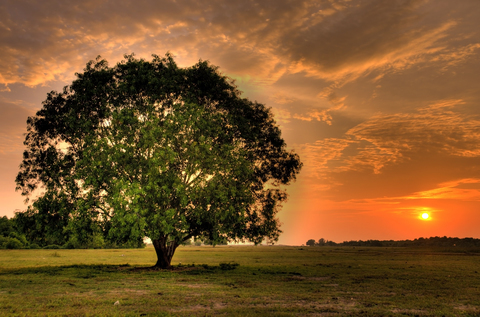
(Credit: Suthesh Nathan via Flickr)
Reading the news, it's hard not to feel a growing sense of unease. The threat of terrorism, growing instability and conflict overseas, a shooting on Parliament Hill last October and uncertainty about the economy diminish our collective feelings of safety and security. To this we add the looming environmental threats of climate change, pollution, declining ocean health, oil spills and extreme weather.
All of it takes a psychological toll, even when we're not directly affected. Studies show that when we feel threatened, we isolate ourselves and focus on restoring our sense of security. Many people attempt to alleviate anxiety by grasping for wealth, seeking pleasure and taking solace in achievement or status. But this strategy backfires. Instead of bolstering our sense of security and well-being, it diminishes it.
Across cultures and regardless of age and gender, people whose values centre on social position and accumulation of money and possessions actually face a greater risk of unhappiness, including anxiety, depression and low self-esteem. In his book The High Price of Materialism, psychology professor Tim Kasser shows how materialistic values undermine well-being, perpetuate feelings of insecurity and weaken the ties that bind us as human beings.
People who are materialistic also tend to be less interested in ecological issues, have negative attitudes toward the environment and demonstrate fewer instances of sustainable behaviour. That's a tragedy for humanity and the rest of life on Earth.
Cross-cultural research in social science has identified a set of consistently occurring human values. Social psychologists refer to one cluster as "extrinsic", or materialistic. These are concerned with our desire for achievement, status, power and wealth. Opposite to those are "intrinsic" values. They relate to caring, community, environmental concern and social justice.
Although each of us carries both, the importance we attach to one set of values tends to diminish the importance of the other. When power values like social status, prestige and dominance come first, the universal values of tolerance, appreciation and concern for the welfare of others are suppressed.
The U.K.-based Common Cause Foundation is synthesizing this growing body of values research. It offers guidance to social change organizations on ways to engage cultural values to further their causes. Because values are like muscles -- they get stronger the more we exercise them -- activists can consciously stimulate intrinsic values in communications and campaigns.
Researchers have also discovered what they call the values "bleed-over effect". Because values tend to exist in clusters, when one is activated, so are compatible neighbouring values. For example, people reminded of generosity, self-direction and family are more likely to support pro-environmental policies than those reminded of financial success and status.
The forces behind planetary crises are complex. History, politics and economics influence how humans act. Social change requires a focus on individual behaviour, corporate responsibility and government policy. In today's unstable political environment, values must also be part of the equation.
That's where we find an important connection between environmental and social justice movements. On a values level, the efforts and strategies to combat climate change and biodiversity loss complement and strengthen those required to bring about greater equality. When environmentalists invoke intrinsic values to increase support for their cause, they also increase support for social justice.
Because values are an important driver of attitudes and behaviour, they are essential to changing social norms. What can we do as individuals? Our social responsibility goes deeper than our consumer habits and voting choices. We need to reflect on what's important to us. We all deserve to feel secure in our homes and communities, but we can't depend on the false sense of security that isolation or materialistic pursuits bring. When psychological insecurity is on the rise, we need to stay committed to the values that make us environmentalists and champions of social justice. Instead of retreating to our corners, let's turn toward one another to re-establish our sense of security and strength.
The good news is that values that support a healthy society and sustainable planet -- self-respect, concern for others, connection with nature, equality -- also make us happiest in the long term. Each one of us is a value prism, subtly bending the light in a particular direction. As Canadians, let's be conscious of where we direct our light.
Hey! Want more DSF? Join David Suzuki on Facebook

June 10, 2015
Five shopping tips to end food waste
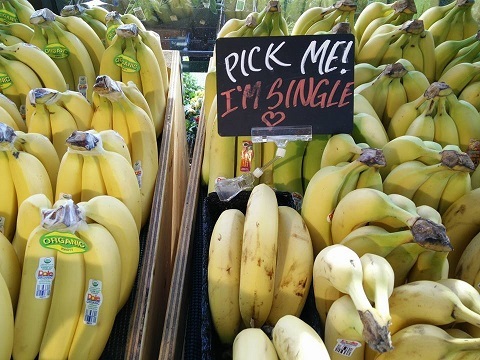
Grab a few single bananas next time instead of choosing a bunch. (Credit: Lindsay Coulter)
Our society wastes food. It's appalling.
Households in Metro Vancouver, where I live, generate about 190,000 tonnes of food waste every year! And over 100,000 tonnes of that could have been eaten.
Our understanding of food waste has come a long way in five years -- when I first shared how to use refrigerator crisper drawers properly.
Now:
There's a movie! Watch Just Eat It: a food waste story (@JustEatItFilm) by filmmakers Grant and Jen, who ate rescued food for six months. It will change the way you shop and cook!
There's a movement. Follow #NoFoodWasted.
It's illegal. Metro Vancouver said, "Food isn't garbage!" and banned organics going to the landfill. Check out Love Food Hate Waste (@LFHW¬ca). And in France, grocery stores can no longer destroy unsold food. They must donate it.
Five shopping and cooking tips to reduce food waste
Pick the first one
This goes for things like dairy items. Don't reach to the back. Grab from the front.
Pick the last one
Nobody likes to be picked last. Same goes for the lonely head of lettuce on display.
Pick the brown, spotted or crooked ones
Imperfect looking produce only wants to be tasted, not wasted (@UglyFruitAndVeg).
Choose overripe produce, sometimes
See that pineapple? It's going to be mouldy tomorrow. And it came all the way from Hawaii! I know it's not organic or local but it's dumpster-bound unless you buy it.
Choose single bananas
Grab a few single bananas next time instead of choosing a bunch.
Are you a food waster? Only you really know. Take the quiz.
Sincerely, Lindsay Coulter
A fellow Queen of Green
Hey! Want more DSF? Join David Suzuki on Facebook

June 9, 2015
G7 nations commit to end carbon pollution
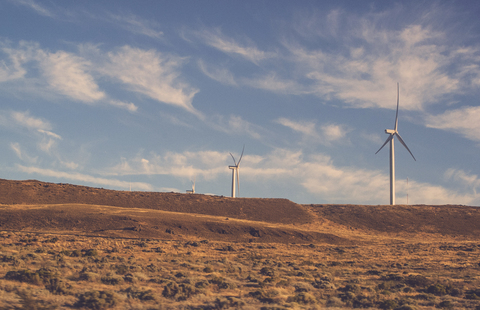
Canada needs to start now to shift policies — such as phasing out fossil fuels, ramping up support for renewable energy alternatives and investing in transit — if it is to take its commitment seriously.
Change can take a long time, but when happens, it often occurs at once. When resistance finally gives way to action it can be difficult to remember why it took so long to get the ball rolling. That is the situation now unfolding at the international level around climate change. The end of 2014 saw an agreement between the world's top two carbon-polluting countries (China and the United States) to cap and reduce their emissions. Since then, state and provincial governments around the world -- including Ontario, Quebec and California -- have made increasingly powerful commitments to support the idea that change is possible.
This week we saw yet another groundbreaking signal of cooperation between governments representing the world's largest economies and biggest carbon emitters aiming to limit the global increase in temperatures to the scientifically agreed upon level of 2°C needed to avoid the worst climatic consequences. On June 8, the G7 released a statement from its leaders' summit in Garmisch-Partenkirchen, Germany, committing member nations to complete "decarbonization" (a zero-emission energy system) before the end of the century. At a stroke, the conversation around carbon pollution has gone from a question of reduction percentages to one about total elimination. For governments, businesses and communities making investment decisions and planning for the future, it's now clear what direction we must take.
This agreement represents a turning point in climate policy for the G7's two climate stragglers: Canada and Japan. Even if, as the Canadian Press reports, these countries worked to weaken the agreement, it marks a significant change in the political discussion: nations won't be able to rely on fossil fuels to power their economies in the long term. The G7 statement on climate change outlined support for the creation of market mechanisms to cut carbon pollution (e.g., carbon taxes and cap-and-trade systems), advocated for investment and governmental promotion of clean energy technologies and called for elimination of inefficient and damaging fossil fuel subsidies from member nations and others.
This change in messaging from some of the world's most influential nations reflects the growing global sentiment that climate change is a threat to the environment, national security and the quality of life of people everywhere. Increasingly, statements denying that climate change is real or arguing that controlling emissions is less important than economic growth are being viewed as ridiculous, irresponsible and dangerous. The conversation has shifted to one about investment in renewable energy solutions and reduced reliance on fossil fuels for transportation through improved public transit networks and electric vehicle use.
The global focus on climate change policy will continue throughout 2015. The July Summit of the Americas and the UN's meeting in New York in September are expected to drive continued commitment from world leaders in advance of the UN's Climate Conference (COP 21) in Paris in December, where it is hoped a binding international commitment on climate action will be reached. Until recently, it appeared Canada would take a backseat at these meetings, but following the G7 agreement there is hope our national leaders may finally be prepared to repair our environmental reputation.
While the message to decarbonize the global economy is clear, how that message will translate into policy in Canada is less so. The National Energy Board, as one example, should use this goal to guide decision-making by incorporating it into energy scenario planning. Canada needs to start now to shift policies -- such as phasing out fossil fuels, ramping up support for renewable energy alternatives and investing in transit -- if it is to take its commitment seriously.
Hey! Want more DSF? Join David Suzuki on Facebook

How to wash fruits and vegetables
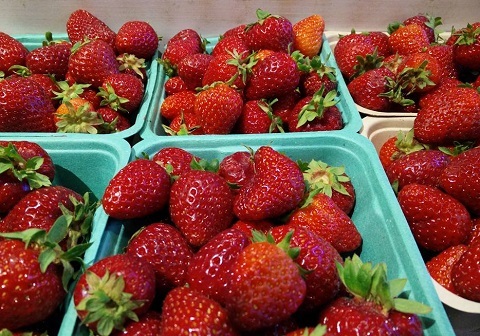
Wash produce before eating, NOT before storing, to prevent rot. (Credit: Lindsay Coulter)
Lots of people touch, sniff and sneeze on produce -- from the farm to the grocery store. So even if you're enjoying organic and local farmers market fruit and veggies, you're bound to encounter dirt and germs (and pesticide residues, if it's not organic) from all the caring hands it passes through.
But don't buy fancy produce washes. Make your own! It's cheaper and avoids plastic containers.
Tip: Wash produce before eating, NOT before storing (which will make it rot faster).
Tip: Firm-skinned produce, such as melons and citrus fruits, needs warm water, a scrub and rinse. Soft-skinned produce, such as strawberries or grapes, needs a soak for a few minutes.
Five ways to wash fruits and vegetables
Eco-friendly liquid soap
Choose a simple, unscented, liquid castile soap. Add a squirt to a sink full of water. It's just like washing your hands to remove germs!
Eco-friendly dish soap
Use what you have with water, such as unscented and antibacterial-free dish soap, which meets these criteria.
Vinegar
Fill a sink with warm water and add plain white vinegar (or apple cider vinegar), one part vinegar to four parts water. Soak, then rinse.
Vegetable glycerin
It's a plant-derived, simple cleanser found at organic grocers or health food stores. Use with water to scrub produce. Rinse. Note: Add a squirt to a 500 ml spray bottle.
Soap nuts
Stir a few soap nuts into water to release the natural saponins in their shells. Make the solution as needed. Note: Soap nuts can be used a few times before composting -- maybe do a load of laundry?
Sincerely, Lindsay Coulter
A fellow Queen of Green
Hey! Want more DSF? Join David Suzuki on Facebook

Ontario restricts bee-killing neonic pesticides
New regulation backed by clear science showing neonics are harmful to pollinators and provide negligible benefits to crop yields
TORONTO, June 9, 2015 -- The government of Ontario published a new regulation today to reduce the use of seeds treated with neonicotinoid pesticides ("neonics"). The controversial family of nicotine-based pesticides has been implicated in the global decline of bees. Ontario is the first jurisdiction in North America to regulate restrictions on the agricultural use of neonics.
"Reducing use of neonics in Ontario is a welcome and necessary first step towards banning these harsh, bee-killing chemicals across Canada," said Lisa Gue, David Suzuki Foundation senior researcher and analyst. "Based on European countries' experience with neonic restrictions, we look forward to healthier pollinator populations and sustained crop yields in years to come."
The regulations follow a landmark study from the international Task Force on Systemic Pesticides, a group of independent scientists that reviewed more than 1,000 published studies about the effects of neonics. The Task Force found clear evidence that neonics are lethal to honeybees and cause a range of harmful effects on other important species such as wild bees, birds, butterflies and earthworms. The authors conclude that current widespread and indiscriminate use of neonics threatens ecosystem functioning and is not sustainable.
Italy banned the use of neonic-treated corn seed in 2008.The following spring, the number of cases of sudden bee die-offs in corn-planting regions dropped to near zero, and the Italian Beekeepers' Association reported that hives were flourishing again. In response to growing concern about pollinator health, a moratorium has been in place in the European Union for the use of three neonics on bee-attracting crops since 2013.
Ontario's new regulation aims to reduce use of neonicotinoid-treated corn and soybean seeds by 80 per cent by 2017. Currently, virtually all corn and 60 per cent of soy crops planted in Ontario are treated with neonics despite government estimates that as much as 90 per cent of these fields do not have relevant pest threats. A leaked report from Canada's Pest Management Regulatory Agency indicates that neonic seed treatments are of little to no value in Canadian corn and soy production.
"The current practice of routinely applying neonics to seeds is like taking a powerful antibiotic each morning when you aren't sick to guard against a possible bacterial infection -- it's clearly overkill with dangerous consequences," continued Gue. "Ontario's determined effort to wean the province from neonics demonstrates that, despite fierce pushback from multibillion dollar companies profiting from pesticide sales, strong science bolstered by public support for protecting pollinators is prevailing."
Amendments to Ontario Regulation 63/09 were published today and will take effect July 1, 2015, with some requirements being phased in over three years.
-30-
Contact: Jode Roberts, David Suzuki Foundation 647-456-9752 jroberts@davidsuzuki.org
Hey! Want more DSF? Join David Suzuki on Facebook

David Suzuki's Blog
- David Suzuki's profile
- 247 followers



